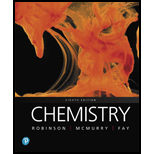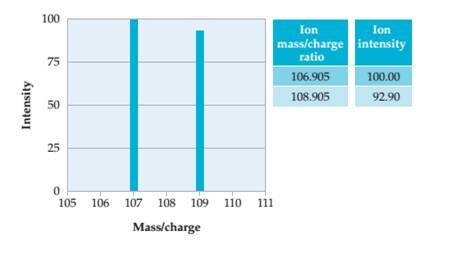
CHEMISTRY-W/MASTERING CHEMISTRY ACCESS
8th Edition
ISBN: 9780135205068
Author: Robinson
Publisher: PEARSON
expand_more
expand_more
format_list_bulleted
Concept explainers
Textbook Question
Chapter 2, Problem 2.13P
Use the data from the mass spectrum of asample of an element to calculate the element’s atomic weight.Identify the clement.

Expert Solution & Answer
Want to see the full answer?
Check out a sample textbook solution
Students have asked these similar questions
Using the following two half-reactions, determine the pH range in which $NO_2^-\ (aq)$ cannot be found as the predominant chemical species in water.* $NO_3^-(aq)+10H^+(aq)+8e^-\rightarrow NH_4^+(aq)+3H_2O(l),\ pE^{\circ}=14.88$* $NO_2^-(aq)+8H^+(aq)+6e^-\rightarrow NH_4^+(aq)+2H_2O(l),\ pE^{\circ}=15.08$
Indicate characteristics of oxodec acid.
What is the final product when hexanedioic acid reacts with 1º PCl5 and 2º NH3.
Chapter 2 Solutions
CHEMISTRY-W/MASTERING CHEMISTRY ACCESS
Ch. 2 - An element is a shiny, silver-colored solid at...Ch. 2 - Prob. 2.2ACh. 2 - PRACTICE 2.3Compounds A and B are colorless gases...Ch. 2 - APPLY 2.4If the chemical formula of compound A in...Ch. 2 - PRACTICE 2.5The gold foil that Rutherford used in...Ch. 2 - Prob. 2.6ACh. 2 - PRACTICE 2.7The isotope 3475Se is used medically...Ch. 2 - APPLY 2.8Element X is toxic to humans in high...Ch. 2 - PRACTICE 2.9Copper metal has two naturally occur-...Ch. 2 - Prob. 2.10A
Ch. 2 - Prob. 2.11PCh. 2 - APPLY 2.12If 2.26 1022 atoms Of element Y have a...Ch. 2 - Use the data from the mass spectrum of asample of...Ch. 2 - Use the data from the mass spectrum of a sample of...Ch. 2 - Which of the following drawings represents a pure...Ch. 2 - Red and blue spheres representatoms of different...Ch. 2 - Thymine, one of the four basesin deoxyribonucleic...Ch. 2 - Prob. 2.18ACh. 2 - Prob. 2.19PCh. 2 - Which of the following drawings most likely...Ch. 2 - Prob. 2.21PCh. 2 - Prob. 2.22ACh. 2 - Prob. 2.23PCh. 2 - Prob. 2.24ACh. 2 - Prob. 2.25PCh. 2 - Prob. 2.26ACh. 2 - Global climate is affected by variations in (a)...Ch. 2 - Prob. 2.28PCh. 2 - How many protons, neutrons, and electrons arein...Ch. 2 - Which sample of H2O has a higher ratio of 18O/16O...Ch. 2 - The last ice age occurred from 110,000 to11,700...Ch. 2 - For this problem, assume that water consistsonly...Ch. 2 - Prob. 2.33PCh. 2 - Prob. 2.34CPCh. 2 - Prob. 2.35CPCh. 2 - Prob. 2.36CPCh. 2 - Prob. 2.37CPCh. 2 - If yellow spheres represent sulfur atoms and red...Ch. 2 - Prob. 2.39CPCh. 2 - Prob. 2.40CPCh. 2 - Which of the following three drawings represents a...Ch. 2 - In the following drawings, red and blue spheres...Ch. 2 - Prob. 2.43CPCh. 2 - Prob. 2.44CPCh. 2 - Prob. 2.45CPCh. 2 - Prob. 2.46SPCh. 2 - Which element accounts for roughly 75% of the...Ch. 2 - Prob. 2.48SPCh. 2 - Prob. 2.49SPCh. 2 - Prob. 2.50SPCh. 2 - Prob. 2.51SPCh. 2 - Prob. 2.52SPCh. 2 - Prob. 2.53SPCh. 2 - Examine Figure 2.2, A portion of Mendeleev’s...Ch. 2 - Prob. 2.55SPCh. 2 - Prob. 2.56SPCh. 2 - Prob. 2.57SPCh. 2 - Prob. 2.58SPCh. 2 - Prob. 2.59SPCh. 2 - Prob. 2.60SPCh. 2 - Prob. 2.61SPCh. 2 - Prob. 2.62SPCh. 2 - Prob. 2.63SPCh. 2 - 2.60 List several general properties of the...Ch. 2 - Prob. 2.65SPCh. 2 - Prob. 2.66SPCh. 2 - Prob. 2.67SPCh. 2 - At room temperature, a certain element is found to...Ch. 2 - Prob. 2.69SPCh. 2 - At room temperature, a certain element is yellow...Ch. 2 - Prob. 2.71SPCh. 2 - Prob. 2.72SPCh. 2 - Prob. 2.73SPCh. 2 - Prob. 2.74SPCh. 2 - Prob. 2.75SPCh. 2 - How does Dalton’s atomic theory account for the...Ch. 2 - Prob. 2.77SPCh. 2 - A sample of mercury with a mass of 114.0 g was...Ch. 2 - Prob. 2.79SPCh. 2 - In methane, one part hydrogen combine with three...Ch. 2 - In borane, one part hydrogen combine with 3.6...Ch. 2 - Benzene, ethane, and ethylene are just three of a...Ch. 2 - Prob. 2.83SPCh. 2 - Prob. 2.84SPCh. 2 - 2.79 In addition to carbon monoxide (CO) and...Ch. 2 - Prob. 2.86SPCh. 2 - What affects the magnitude of the deflection of...Ch. 2 - Prob. 2.88SPCh. 2 - Prob. 2.89SPCh. 2 - Which of the following charges is NOT possible for...Ch. 2 - What discovery about atomic structure was made...Ch. 2 - Prior to Rutherford’s gold foil experiment, the...Ch. 2 - A period at the end of sentence written with a...Ch. 2 - A 1/4 inch thick lead sheet is used for protection...Ch. 2 - Prob. 2.95SPCh. 2 - What is the difference between an atom’s atomic...Ch. 2 - Prob. 2.97SPCh. 2 - Prob. 2.98SPCh. 2 - Prob. 2.99SPCh. 2 - Prob. 2.100SPCh. 2 - The radioactive isotope cesium-137 was produced in...Ch. 2 - Prob. 2.102SPCh. 2 - Prob. 2.103SPCh. 2 - How many protons, neutrons, and electrons are in...Ch. 2 - Prob. 2.105SPCh. 2 - Prob. 2.106SPCh. 2 - Prob. 2.107SPCh. 2 - Prob. 2.108SPCh. 2 - Prob. 2.109SPCh. 2 - Fluorine occurs naturally as a single isotope. How...Ch. 2 - Hydrogen has three isotopes (1H,2H,and3H) , and...Ch. 2 - The unified atomic mass unit (u) is defined as...Ch. 2 - Prob. 2.113SPCh. 2 - Prob. 2.114SPCh. 2 - Label the following statements as true or false....Ch. 2 - Copper has two naturally occurring isotopes,...Ch. 2 - Sulfur has four naturally occurring isotopes,...Ch. 2 - aturally occurring boron consists of two isotopes:...Ch. 2 - Prob. 2.119SPCh. 2 - Magnesium has three naturally occurring isotopes:...Ch. 2 - A sample of naturally occurring silicon consists...Ch. 2 - Copper metal has two naturally occurring isotopes:...Ch. 2 - Germanium has five naturally occurring...Ch. 2 - What is the mass in grams of each of the following...Ch. 2 - How many moles are in each of the following...Ch. 2 - If the atomic weight of an element is x, what is...Ch. 2 - If the atomic weight of an element is x, what is...Ch. 2 - Prob. 2.128SPCh. 2 - If 4.611021 atoms of element Z have a mass of 0.8...Ch. 2 - Refer to Figure 2.10 showing a schematic...Ch. 2 - Copper has two naturally occurring isotopes,...Ch. 2 - Use the data from the mass spectrum of a sample of...Ch. 2 - Use the data from the mass spectrum of a sample of...Ch. 2 - Prob. 2.134SPCh. 2 - Which of the following bonds are likely to be...Ch. 2 - The symbol CO stands for carbon monoxide, but the...Ch. 2 - Prob. 2.137SPCh. 2 - Prob. 2.138SPCh. 2 - Prob. 2.139SPCh. 2 - Prob. 2.140SPCh. 2 - Prob. 2.141SPCh. 2 - Prob. 2.142SPCh. 2 - Prob. 2.143SPCh. 2 - Prob. 2.144SPCh. 2 - Prob. 2.145SPCh. 2 - Give systematic names for the following binary...Ch. 2 - Give systematic names for the following binary...Ch. 2 - Prob. 2.148SPCh. 2 - Prob. 2.149SPCh. 2 - Prob. 2.150SPCh. 2 - Prob. 2.151SPCh. 2 - Give systematic names for the following compounds:...Ch. 2 - Name the following ions: (a) Ba2+ (b) Cs+ (c) V3+...Ch. 2 - Prob. 2.154SPCh. 2 - Prob. 2.155SPCh. 2 - Prob. 2.156SPCh. 2 - Prob. 2.157SPCh. 2 - Prob. 2.158SPCh. 2 - Prob. 2.159SPCh. 2 - Prob. 2.160SPCh. 2 - Prob. 2.161SPCh. 2 - Prob. 2.162SPCh. 2 - Prob. 2.163SPCh. 2 - Prob. 2.164SPCh. 2 - Prob. 2.165SPCh. 2 - Ammonia (NH3) and hydrazine (N2H4) are both...Ch. 2 - If 3.670 g of nitrogen combines with 0.5275 g of...Ch. 2 - Prior to 1961, the atomic mass unit (amu) was...Ch. 2 - What was the mass ¡n atomic mass units of a 40Ca...Ch. 2 - Prob. 2.170MPCh. 2 - The mass percent of an element in a compound is...Ch. 2 - In an alternate universe, the smallest negatively...
Knowledge Booster
Learn more about
Need a deep-dive on the concept behind this application? Look no further. Learn more about this topic, chemistry and related others by exploring similar questions and additional content below.Similar questions
- What is the final product when D-galactose reacts with hydroxylamine?arrow_forwardIndicate the formula of the product obtained by reacting methyl 5-chloro-5-oxopentanoate with 1 mole of 4-penten-1-ylmagnesium bromide.arrow_forwardIn the two chair conformations of glucose, the most stable is the one with all the OH groups in the equatorial position. Is this correct?arrow_forward
- please help me with my homeworkarrow_forwardhelparrow_forwardThe temperature on a sample of pure X held at 1.25 atm and -54. °C is increased until the sample boils. The temperature is then held constant and the pressure is decreased by 0.42 atm. On the phase diagram below draw a path that shows this set of changes. pressure (atm) 2 0 0 200 400 temperature (K) Xarrow_forward
- QUESTION: Answer Question 5: 'Calculating standard error of regression' STEP 1 by filling in all the empty green boxes *The values are all provided in the photo attached*arrow_forwardpressure (atm) 3 The pressure on a sample of pure X held at 47. °C and 0.88 atm is increased until the sample condenses. The pressure is then held constant and the temperature is decreased by 82. °C. On the phase diagram below draw a path that shows this set of changes. 0 0 200 temperature (K) 400 аarrow_forwarder your payment details | bar xb Home | bartleby x + aleksogi/x/isl.exe/1o u-lgNskr7j8P3jH-1Qs_pBanHhviTCeeBZbufuBYT0Hz7m7D3ZcW81NC1d8Kzb4srFik1OUFhKMUXzhGpw7k1 O States of Matter Sketching a described thermodynamic change on a phase diagram 0/5 The pressure on a sample of pure X held at 47. °C and 0.88 atm is increased until the sample condenses. The pressure is then held constant and the temperature is decreased by 82. °C. On the phase diagram below draw a path that shows this set of changes. pressure (atm) 1 3- 0- 0 200 Explanation Check temperature (K) 400 X Q Search L G 2025 McGraw Hill LLC. All Rights Reserved Terms of Use Privacy Cearrow_forward
arrow_back_ios
SEE MORE QUESTIONS
arrow_forward_ios
Recommended textbooks for you
 Chemistry: Principles and PracticeChemistryISBN:9780534420123Author:Daniel L. Reger, Scott R. Goode, David W. Ball, Edward MercerPublisher:Cengage Learning
Chemistry: Principles and PracticeChemistryISBN:9780534420123Author:Daniel L. Reger, Scott R. Goode, David W. Ball, Edward MercerPublisher:Cengage Learning Chemistry for Engineering StudentsChemistryISBN:9781285199023Author:Lawrence S. Brown, Tom HolmePublisher:Cengage Learning
Chemistry for Engineering StudentsChemistryISBN:9781285199023Author:Lawrence S. Brown, Tom HolmePublisher:Cengage Learning Chemistry: An Atoms First ApproachChemistryISBN:9781305079243Author:Steven S. Zumdahl, Susan A. ZumdahlPublisher:Cengage Learning
Chemistry: An Atoms First ApproachChemistryISBN:9781305079243Author:Steven S. Zumdahl, Susan A. ZumdahlPublisher:Cengage Learning Chemistry: Principles and ReactionsChemistryISBN:9781305079373Author:William L. Masterton, Cecile N. HurleyPublisher:Cengage Learning
Chemistry: Principles and ReactionsChemistryISBN:9781305079373Author:William L. Masterton, Cecile N. HurleyPublisher:Cengage Learning Chemistry & Chemical ReactivityChemistryISBN:9781337399074Author:John C. Kotz, Paul M. Treichel, John Townsend, David TreichelPublisher:Cengage Learning
Chemistry & Chemical ReactivityChemistryISBN:9781337399074Author:John C. Kotz, Paul M. Treichel, John Townsend, David TreichelPublisher:Cengage Learning Chemistry & Chemical ReactivityChemistryISBN:9781133949640Author:John C. Kotz, Paul M. Treichel, John Townsend, David TreichelPublisher:Cengage Learning
Chemistry & Chemical ReactivityChemistryISBN:9781133949640Author:John C. Kotz, Paul M. Treichel, John Townsend, David TreichelPublisher:Cengage Learning

Chemistry: Principles and Practice
Chemistry
ISBN:9780534420123
Author:Daniel L. Reger, Scott R. Goode, David W. Ball, Edward Mercer
Publisher:Cengage Learning

Chemistry for Engineering Students
Chemistry
ISBN:9781285199023
Author:Lawrence S. Brown, Tom Holme
Publisher:Cengage Learning

Chemistry: An Atoms First Approach
Chemistry
ISBN:9781305079243
Author:Steven S. Zumdahl, Susan A. Zumdahl
Publisher:Cengage Learning

Chemistry: Principles and Reactions
Chemistry
ISBN:9781305079373
Author:William L. Masterton, Cecile N. Hurley
Publisher:Cengage Learning

Chemistry & Chemical Reactivity
Chemistry
ISBN:9781337399074
Author:John C. Kotz, Paul M. Treichel, John Townsend, David Treichel
Publisher:Cengage Learning

Chemistry & Chemical Reactivity
Chemistry
ISBN:9781133949640
Author:John C. Kotz, Paul M. Treichel, John Townsend, David Treichel
Publisher:Cengage Learning
Mass Spectrometry; Author: Professor Dave Explains;https://www.youtube.com/watch?v=hSirWciIvSg;License: Standard YouTube License, CC-BY